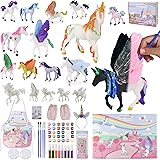"The Art of Origami: A Step-by-Step Guide to Creating Stunning Figures"
An introduction to the Japanese art of origami and its history is presented. Then, it offers a detailed step-by-step guide to creating various popular figures, such as cranes, flowers, and animals. Include clear photos or illustrations at each step and tips for choosing the right paper and solving common problems.
Introduction:
Origami, the Japanese art of folding paper to create three-dimensional figures, has fascinated people around the world for centuries. With just a few basic techniques and a little patience, you can turn a simple sheet of paper into something amazing. In this guide, you will learn step by step how to create various popular figures, such as cranes, flowers, and animals. We'll also offer tips on how to choose the right paper and troubleshoot common problems in the process.
Paper crane
The crane is undoubtedly one of the most iconic figures of origami. It represents peace and good fortune and is an excellent project for beginners.
Materials:
- Square paper (preferably 15×15 cm)
Steps:
- Fold the paper in half diagonally, forming a triangle. Unfold and repeat the process on the other diagonal.
- Fold the paper in half in both sent
- Idos, forming a smaller square. Unfold to reveal the guiding lines. 3. Using the guide lines, fold the paper inward forming a figure known as the "kite base."
- Fold the upper flaps downwards, forming a rhombus. Make sure the edges are aligned.
- Fold the lower flaps towards the center of the rhombus and then unfold.
- Make a reverse fold on the lower flaps, using the folds you just made as a guide, creating a figure known as the "base of the bird".
- It folds the two wings down in the opposite direction to the head and tail.
- To create the crane head, make a reverse fold at one end.
Origami flower
Origami flowers are popular and attractive, ideal for decorations or gifts. Here's how to create a simple flower.
Materials:
- Square paper (preferably 10×10 cm)
Steps:
- Fold the paper in half horizontally and vertically, and unfold to reveal the guide lines.
- Fold each corner toward the center of the paper, using the guide lines.
- Again, bend each corner toward the center of the paper.
- Fold up the flaps at each corner, creating petals.
- Rotate the paper and fold each spout toward the center, forming a small hexagon in the middle.
- Turn the paper again and carefully lift the petals that formed in step 4.
Origami elephant
Origami animals are fun and challenging. Here's how to make a simple elephant.
Materials:
- Square paper (preferably 20×20 cm)
Steps:
- Fold the paper in half diagonally, forming a triangle. Unfold and repeat the process on the other diagonal.
- Fold the paper in half horizontally and vertically, and unfold to reveal the guide lines.
- Using the guide lines, fold the paper inward forming a figure known as the "kite base."
- Fold the lower flap upwards, aligning it with the lower edge of the ears.
- Make a reverse fold at the tip of the lower flap to form the elephant's trunk.
- Fold the figure in half along the central axis and perform a reverse fold at the bottom to create the hind legs.
- Bend the front legs down and outward, adjusting the angle as needed.
Tips for choosing the right role:
- Traditional origami paper, known as "kami," is a popular choice due to its thinness and ease of folding.
- Tissue paper or onion paper also work well for delicate and detailed figures.
- For larger or stronger projects, kraft paper is a good choice
Troubleshooting common problems:
- Crumpled paper: If the paper wrinkles when folding, try to make the folds more carefully and gently. You can also use a tool like a bone fold to help you make sharper folds.
- Unaligned edges: Make sure the edges of the paper are perfectly aligned before making each fold. This will help you get more accurate and clean results.
- Difficulty in reverse folds: If you have trouble performing reverse folds, practice with a piece of waste paper until you are comfortable with the technique.
- Figures that do not hold in their shape: If the figure does not maintain its shape, you can use small pieces of transparent adhesive tape to secure the loose parts. You can also gently spray the finished figure with hairspray or spray glue to hold it in place.
- In short, the art of origami is a creative and relaxing activity that allows you to transform simple sheets of paper into impressive figures. With this step-by-step guide and a little patience, you'll be able to create













